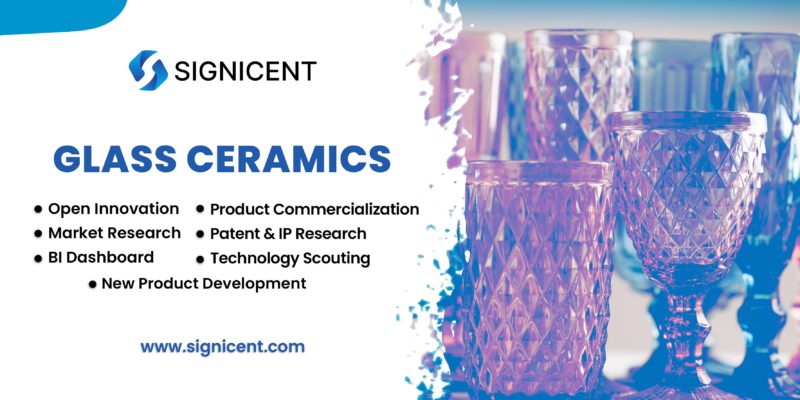This glass ceramics report demonstrates the analysis to check available technologies, solutions to existing problems, emerging innovations, applications in glass packaging & start-ups related to glass ceramics and related materials.
Glass-ceramics combine the properties of glasses with the benefits of conventional sintered ceramics. Glass-ceramics have certain advantages including almost zero thermal expansion, high toughness, zero thermal expansion, resistance to thermal shock, etc. Glass-ceramics can be subdivided into two categories: oxide and non-oxide.
Oxide glass-ceramics include silicate (SiO2), borate (B2O3), phosphate (P2O5), and germinate (GeO2) type materials. Non-oxide glass-ceramics include chalcogenide, halide, and metallic type. Corning provides high-quality, innovative products for life sciences applications for different categories like glassware, cell culture, filtration, etc.
Challenges in Glass Ceramics Report
It becomes essential to combat the concerns, therefore to understand the industry challenges, we thoroughly investigated thousands of scientific literature, patent literature, and recent inventions. We came across the following challenges that are most commonly faced:
- Boron oxide containing glasses are toxic and costly.
- Extractables from glass containers for packing and storing pharmaceuticals may change the properties of medicine which can affect the health of the subject.
- Extra workload is caused due to requirement of accurate movements during pipetting. During a working day, hundreds of pipetting may be needed which can cause injuries.
Solutions
Post comprehensive analysis of publicly and commercially available information, we came across the following viable, innovative, and possibly the finest solutions to overcome the aforementioned problems respectively in Glass Ceramics Report:
- Boron-oxide free glass having chemical resistance used for primary packaging in pharmaceutical industry.
- Borosilicate glass resistant to delamination having excellent processability and hydrolytic resistance.
- A tracking element in pipette is provided which is able to count the magnitude relating to the amount of use of pipette and when the magnitude exceeds certain limit, the user is informed.
Emerging Technologies in Glass Ceramics Report
Traditionally they are manufactured in a process where they undergo specific heat treatment. This forms the basis for controlled nucleation and crystallization of the glass. Then the glass partially crystallizes and forms an amorphous (glassy) phase with at least one embedded crystalline phase. This traditional method is being dealt with an innovative approaches, some of them are as follows.
The pace with which technology is advancing, only innovative technologies can thrive in the market. Here we are sharing a glimpse of innovations happening in glass ceramics industry.
We analyzed a patent by Schott AG that unveils a boron-oxide-free glass is for use in primary packaging in the pharmaceutical industry wherein glass comprises SiO2, Al2O3, Na2O, CaO, etc. but lacks B2O3.
We analyzed a patent by Nippon Electric Glass Co Ltd that unveils borosilicate glass for pharmaceutical containers comprising SiO2, Al2O3, B2O3, Li2O+Na2O+K2O, CaO, etc. which is resistant to delamination, can be easily processed into a complex shape and excellent hydrolytic resistance. The smaller the amount of SiO2 extracted, the higher the delamination resistance.
We analyzed a patent in Glass Ceramics Report by Thermo Fisher Scientific Oy that unveiled that a pipette comprising a piston, a control system, one tracking element wherein the tracking element can count the magnitude of at least one variable which indicates the amount of use and operating time of the pipette. The user is informed by a sound signal or display signal when he/she may be exposed to high workload stress which may cause injury.
Each year Signicent provides consultancy to hundreds of organizations to help transform their innovations to value.
Innovations in Glasses
AFT Fluorotec has worked on innovative coatings for scientific applications. The product includes PTFE, PFA, PEEK coatings for chemical protection, corrosion resistance, wear-resistant, heat-resistant, cryogenic protection. These coatings can be applied to glass, ceramics, plastics, rubbers metals, and elastomers.
DWK Life Sciences is marketing safety coated glass with the brand name KIMCOTE®. It is designed with PVC coating which keeps glassware fragments intact in case of accidental breakage. Applications include handling hazardous chemicals, transportation of samples, preserving precious samples.
Schott in 2018 launched syriQ BioPure is a highly customizable glass prefillable staked-needle syringe designed to ensure drug stability and safe administration of sensitive drugs made with FIOLAX® borosilicate glass tubing.
Innovative Products in Glass Ceramics Report
ThermoFisher has a Sterilin™ Borosilicate Glass Culture Tube. It is highly resistant to temperature and chemical attacks. It is also ideal for use with samples sensitive to leaching from plastic tubes. It is supplied without caps. The autoclavable caps are available separately.
ADELPHI has manufactured Moulded Glass Injection Vials & Freeze Drying Vials. These are manufactured according to ISO 8362-4. It is made from molded neutral Type I glass. The standard 13mm and 20mm is the neck size. It is available in clear and amber glass.
SCHOTT has produced SCHOTT Type I plus® . The SCHOTT Type I plus® vials greatly reduces drug-container interaction. It has an increased shelf life for highly sensitive drug formulations. It has minimal adsorption of radioactive molecules.
Global Glass Ceramics Market
The Global Glass Ceramics Market is estimated to be USD 1.29 billion in 2020 and is growing at a CAGR of 5.7% during the forecast period of 2020-2025 to reach USD 1.7 billion by 2025. The boom in the construction industry will offer immense growth opportunities. Also, as glass-ceramics are used in the aerospace industry it will further drive the growth. Moreover growing government spending on infrastructural development is further driving the growth.
Mergers & Acquisitions
In 2019, SCHOTT AG, a leading international technology group in the areas of specialty has entered into a purchase agreement to acquire the Australian microfluidic company MINIFAB Pty Ltd. And Borosil Glass Works has acquired 60.3% shares in Nashik-based Klasspack, a glass packaging firm, for an undisclosed amount in 2016.
